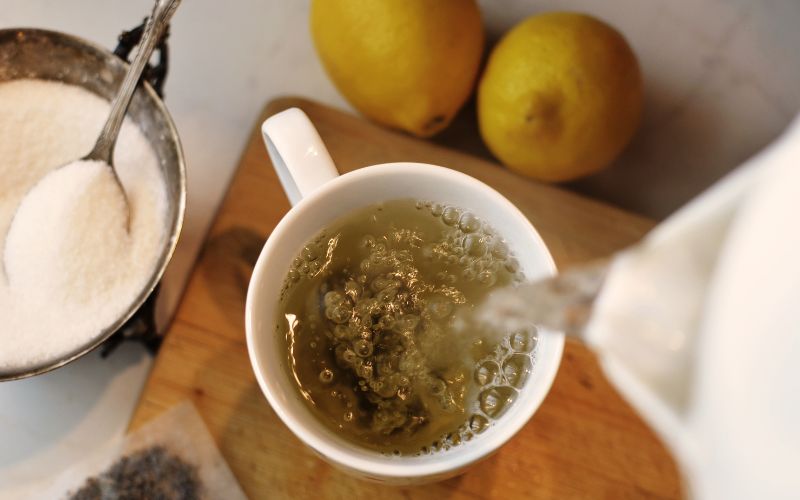Why Is There Stuff Floating In My Arizona Tea?
Last updated on October 26th, 2022 at 05:19 pm
A lot of ingredients come together to produce the Arizona tea. With so many factors in the mix, particles and other things can find their way into the tea.
Even chemical reactions can lead to the formation of such fragments. In this article, you’ll find out what these particles are.
The stuff floating in Arizona green tea can be mold, slime, leaves, or particles from chemical formations. Some of these form due to exposure to air or contact with water. High temperatures recorded when transporting the tea could also contribute to the particles found in the tea.
What Is Floating On My Arizona Tea?

Arizona tea made from green leaves can have an oil film floating on the tea’s surface.
When the tea contacts boiling water, scum appears because of the chemical reaction between tea and water.
Research has discovered that the scum contains around 15 to 25 percent calcium carbonate.
The remaining percentage constitutes various mixtures of different minerals. Sometimes you can also find a slime-like substance in the tea.
During tea production, pigments appear when tea leaves are fermenting. The pigments remain after the evaporation of the tea beverage.
The pigments, therefore, cause the slime-like substance to float on the tea. In addition, there can be mold spores floating in the tea.
Mold spores look spherical and fuzzy; they grow well when the temperature is warm. Their growth is also encouraged by air squeezing in through a broken seal.
An oily film can also appear on the surface of your Arizona green tea. Molecules of calcium carbonate and polyphenols present in the tea cause this film.
Brewing the tea in tap water causes this film to appear. Tap water in most locations flows out of limestone aquifers.
Calcium carbonate is found in tap water and gives the water a crisper taste. That’s why this kind of water contributes to the sweet taste of tea.
Why Is There Brown Stuff In My Arizona Ice Tea?
Arizona Ice tea has many ingredients that might contribute to the brown stuff found in the tea.
There is citric acid and high-fructose golden syrup. The citric acid comes from strains like the Aspergillus niger mold.
Bacteria are fond of growing inside this tea, and polyphenols in the ingredients settle at the surface.
Also, contamination of the tea leaves by coliform bacteria can bring about particles.
Bacteria will form if the tea brews at low temperatures or in a soiled vessel.
Even prolonged storage can cause bacteria like Enterobacter, E. coli, and Klebsiella to contaminate the tea. All these factors can produce the brown stuff in the Arizona ice tea.
Furthermore, with compounds like polyphenols and theaflavin present, particles could form due to heat shock.
These compounds oxidize when put under intense temperature shock like refrigeration.
When they oxidize, they combine with the caffeine in the tea to create particles. The particles, though, remain dissolved when the tea is hot.
However, when the tea cools down, the particles form up and float in the tea.
Is It Normal For Arizona Ice Tea To Have Particles?
It is normal for Arizona ice tea to have particles. Some of the ingredients in Arizona tea come from some of these particles.
Vegetable juices, fruits, annatto, and beta carotene are some of the ingredients used in the production of this tea.
These ingredients might not be processed properly and have some residue.
Particles can also form when polyphenols, proteins, tannins, and other compounds bind.
Some of the compounds that form these particles in Arizona tea are;
#1. Tannins
Strictinin is in a group of tannins and is known as an ellagitannin. When brewed at high temperatures, strictinin combines with water and forms an ellagic acid.
The ellagic acid then reacts with proteins to create particles. Caffeine and tannins molecules also bond together to form particles.
Tannin has antioxidant properties, and its purpose is to expel dangerous bacteria from the body. Ellagic acids, tannin, and strictinin are all polyphenols.
These compounds all provide various health benefits and are important in tea.
Usually, tea that has undergone brewing for a long time will develop more tannin and caffeine.
#2. Calcium
Calcium is important for muscle cells and neuronal function. This compound is responsible for particles in Arizona ice tea.
Organic acids combine with calcium which can create particles. A tea brewed in hard water will cause this.
Hard water has magnesium and calcium; the water acts as a solvent for these earth metals.
All these dissolved solids can quickly form particles after the tea cools down.
Is It Safe To Drink Arizona Tea With Particles?
You can drink Arizona tea that has particles in it. These particles form when various compounds mix.
These compounds are not only safe to drink; they also have some health benefits.
Most times, particles appear due to oxidation and heat shock meaning the tea is still safe to consume.
Below are the compounds and their benefits.
| Compound | Benefits |
|---|---|
| Polyphenols | Serve as antioxidants and lessen free radical’s harmful effects |
| Strictinin | Have anti-inflammatory, prebiotic, anti-cancer, cardioprotective, and antioxidant properties. |
| Theaflavins | This compound has glucose lessening, anti-obesity, and anti-atherosclerotic properties. |
How to Know If Tea Is Bad
The presence of particles doesn’t always mean well. Mold is one of the factors that can help you know that tea is bad.
The tea will have a strong moldy odor, and there’ll be visible mold in the tea.
Molding starts in tea leaves, but even when there are no leaves, the surface of the tea can start molding.
Some molds can produce mycotoxins. If your immune system is strong, it can fend off this kind of mold.
However, a high concentration of this mold will cause illness in a weak immune system.
Drinking mycotoxins can lead to stomach upsets and even life-threatening illnesses.
When tea is bad, it loses its taste. Tea develops tastelessness when it has stayed over a long time.
A sour and dull taste replaces the sharp and fresh taste. This occurrence is mostly due to exposure to air.
What Is The Stuff At The Bottom Of My Arizona Tea?
Tea is a product of leaves. Tea producers harvest young tea leaves because, at this point, they are at their sweetest.
The stuff found at the bottom of your Arizona tea can be trichomes that grow on such leaves.
Trichomes are similar to tea, so if the colors don’t match, the particles could be leaves or other things.
Other stuff you can find at the bottom of your Arizona tea includes;
#1. Tea Leaves
Tea leaves are one of the many things that can be at the bottom of your tea. If the particles you see are the same color as the tea, there’s no need to worry.
They may be leaves that passed through the production process and settled at the tea’s bottom.
#2. Tea Slime
Slime also appears in tea and isn’t dangerous most times but looks unappealing. They appear when chemicals combine in the tea.
Hard water is also a factor; this kind of water causes slime since it has great calcium content. Any slime found in the tea has up to 15 percent calcium.
#3. Mold and SCOBY
Mold is one of the things that can easily form in tea. Some of this mold is harmless and causes no issues.
SCOBY is an acronym for Symbiotic Culture of Bacteria and Yeast. It has a leathery and slimy look and can find its way to the bottom of your tea.
SCOBY is a colony of valuable yeast and bacteria in a cellulose bed. It is an ingredient added during the production of Arizona tea.
After a long time, the SCOBY causes the tea to ferment, which can make it cluster at the tea’s bottom.
#4. Gelatinous Mold
Gelatinous mold appears in tea whenever the tea comes in contact with air that carries mold spores.
These spores start increasing, creating a form of mass in the tea. This mold isn’t harmful to the body but can look disgusting.
#5. Mycotoxins
Mycotoxins can be dangerous. Mold produces mycotoxins, and tea can carry mold at any time. Mold can contaminate tea leaves before harvesting.
Usually, leaves get mold in the production process. These molds can tolerate an immense amount of heat like boiling water.
Aflatoxin is an example of such notorious mold; its spores need to boil for 60 minutes before they die.
Therefore, these molds can easily pass through the tea production process to the final product.
So if you find a moldy substance at the bottom of your tea, it could be mycotoxins.
Conclusion
Proteins, tannins, and calcium are some of the compounds found in tea. These compounds combine to form particles.
The particles found in Arizona tea include slime, mold, leaf fragments, or chemical formations.
Some of the particles are harmless and consumable. Mycotoxins are one of the dangerous substances found in Arizona tea.






